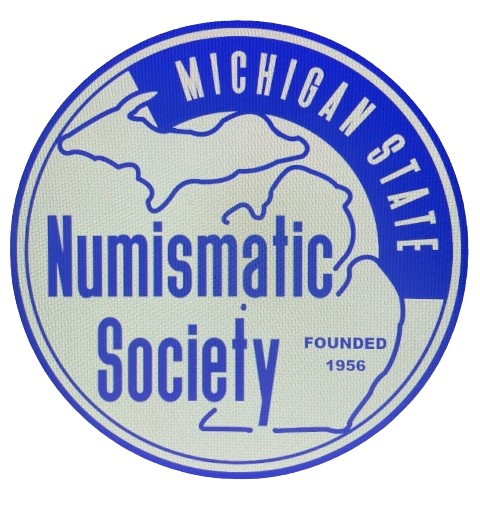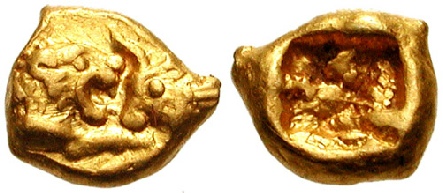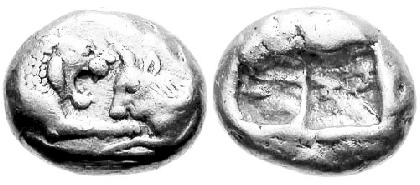


The Michigan State Numismatic Society







Lydian Coinage Under King Kroises
by Sam Spiegel MSNS J-9160
Lydian Coinage Under King Kroises
by Sam Spiegel MSNS J-9160
According to the Greek historian Herodotus, King Kroises of Lydia was the first person to issue bimetallic currency, meaning that they used both gold and silver coins. But before Kroises, Lydian coinage was in great disarray. There were denominations ranging from the 14g stater to the .15g 1/96 stater. As one would guess, some of these denominations were too small to use. Another problem with these coins was the metal they were made from; electrum. Electrum is a natural occurring alloy of gold and silver, so the proportions are not always the same, so the values were not consistent. This is because the gold in the coin ranges from about 20% to 80%.
These early coins had the royal Lydian symbol on the obverse; the lion. When Kroises came to power, he retained this symbol, but also added a bull. There are many theories as to why he put this new symbol on. Some say that the lion represents Asia, and the bull, Europe, symbolizing his power (Asia) conquering the Greeks (European). Kroises was king from 560 to 546 BCE. He made many important reforms that are still in use today. But his reforms were mostly just trial and error. His first monetary issue was of the old electrum standard. His second issue, however, was made of gold but only had ¾ the weight of the old electrum stater, because it was thought that electrum was worth ¾ the value of gold. This new coin had the same purchasing power as the old one. On the third try, Kroises’s economist thought up the bimetallic system. This may seem very complicated at first, but it makes sense in the end:
Table of Lydian Currency
There was one gold stater = 8.04g
There were 2 silver coins:
1 that weighed 10.72g
1 that weighed 5.36g (half of the first one)
If you take 10 of the first, or 20 of the second, you get 107.2g
*Back then, the value ratio of silver to gold was 13.3 : 1*
Knowing that, one then divides 107.2 by 13.3, getting 8.04g.
(the weight of the gold stater)
So 10 silver pieces of 10.72 each = 1 gold coin of 8.04
And 20 silver pieces of 5.36 each = 1 gold coin of 8.04
This system seems quite complex for being made 2,500 years ago. Of course, each coin was hand made so one must factor in human error; each coin was not going to be of the perfect weight, but it would be close enough.
This "phenomenon" quickly spread through the rest of Asia Minor and then into Europe. Even after the Persian conquest of Lydia, they allowed the Lydians to keep their coinage, even though the rest of the empire was on the Babylonian standard. Lydian coinage is rather "small" compared to that of other city-states and kingdoms, but it was pivotal in the development of modern coinage.


Gold stater of Kroises and Silver stater of Kroises (both images Classical Numismatic Group)
Yet what about King Kroises himself? He was the son of Alayattes II, and came to power in about 560 BC. Already when he came to power, Lydia was a rather significant kingdom in Asia Minor and, and Kroises followed in his father’s foot-steps by conquering the cities in Ionia. Yet Kroises was significantly nicer to Greeks than his father. He even sheltered the Athenian statesman Solon (who later would form the weight standards for the Athenian drachmas), after he had reformed Athens’ laws. It was part of their agreement that the Athenian try out Solon’s laws for 5 years to see if they worked, and during that time, Solon didn’t want to be there if they didn’t go right.
Anyway, it was during this stay that Solon and Kroises had their legendary conversation. Kroises asked Solon who was the happiest man in the world (expecting him to say him), but Solon said that it was an Athenian man named Tellus. Kroises was angered that he did not say himself, but he questioned him as to why he did say this "Tellus". Solon replied that he had a prosperous city, had fine son to be proud of, had enough money to live comfortably, and died gloriously in battle for his city-state. Then Kroises, thinking he would be awarded second prize, asked him who the next happiest person in the world was. Solon replied that it was two young men from Argos, who had enough money and were very strong. There was an instance which proved this, but it is rather lengthy, so it is not included in this article*. Just let it be known that they died gloriously in a religious festival. Kroises was very angry at Solon, and finally asked him about his own happiness. Solon said that humans are "creatures of chance", so Kroises could be rich one day, but poor the next. One will never know if one is truly happy, unless they are happy until the end; until they die. The following is a quote from The Histories (so do not expect it to be true): Solon: "But mark this: until he is dead, keep the word ‘happy’ in reserve. Till then, he is not happy, only lucky."
There may have been some relation between this encounter and the creation of coinage in mainland Greece. It might have been an exchange of ideas. Kroises learned a very important lesson about happiness, and Solon probably learned of Lydia’s ingenious coinage system.
Kroises allied himself with Amasis II of Egypt and Nabonidus of Babylonia, for he knew he would need their help in a campaign he was launching against a new threat to him; Cyrus of Persia. Before starting the campaign, though, he went to the Oracle of Delphi, and she said "You shall destroy a powerful empire". As he launched his army out, he was met by Cyrus at the river Halys. But as winter drew, Kroises disbanded his army, as was the custom in those days. Cyrus, on the other hand, did not, and launched an attack against Kroises in his capitol at Sardis, and captured him.
Cyrus ordered Kroises to be set upon a pyre and see if any heavenly power would stop him from being burned. It appeared that none would, and as the fire caught a hold of him, Kroises suddenly remembered something, and cried out Solon’s name, for he had remembered now what Solon had said and realized he would not be a happy man since he would die unhappy. When translators asked Kroises who Solon was, he explained what Solon had said to him, and they in turn told Cyrus what he had said, who was touched by this, and ordered the fire put out. But, alas, the fire was too strong. Somehow, though, Kroises had realized that Cyrus had changed his mind, and cried out to Apollo to save him. Suddenly, rain clouds gathered above Kroises, and put the fire out. Now, obviously, this is not factual, this is only how Herodotus relates it, but I, personally, like this version better. After he was saved, Cyrus hired Kroises to be part of his counsel, and that is where he stayed until the end of his days.
And so, that is the life of Kroises, as Herodotus says it is. There is much more to the life of Kroises, but these stories are some of the more interesting. Also, a lot of what was said may be false, for Herodotus was a known liar, but I like to think of it as though it were true.
| Board Committees |
| Board Minutes |
| Board Agendas |
| 2021 Spring Activites |
| 2021 Spring Exhibit Sponsors |
| 2021 Spring Pictures |
| 2021 Spring Dealers |
| 2020 Fall Activities |
| 2020 Fall Exhibit Sponsors |
| 2020 Fall Pictures |
| 2020 Fall Dealers |
| 2020 Spring Activities |
| 2020 Spring Exhibit Sponsors |
| 2020 Spring Pictures |
| 2020 Spring Dealers |
| 2019 Fall Activities |
| 2019 Fall Exhibit Sponsors |
| 2019 Fall Convention Dealers |
| 2019 Fall Pictures |
| 2019 Spring Activities |
| 2019 Spring Exhibit Sponsors |
| 2019 Spring Convention Dealers |
| 2019 Spring Convention Photos |
| 2018 Fall Activities |
| 2018 Fall Exhibit Sponsors |
| 2018 Fall Convention Dealers |
| 2018 Fall Convention Photos |
| 2018 Spring Activities |
| 2018 Spring Exhibit Sponsors |
| 2018 Spring Convention Dealers |
| 2018 Spring Convention Photos |
| 2017 Fall Activities |
| 2017 Fall Exhibit Sponsors |
| 2017 Fall Convention Dealers |
| 2017 Fall Convention Photos |
| 2017 Spring Activities |
| 2017 Spring Exhibit Sponsors |
| 2017 Spring Photos |
| 2017 Spring Convention Dealers |
| 2016 Fall Activities |
| 2016 Fall Pictures |
| 2016 Fall Exhibit Sponsors |
| 2016 Spring Activities |
| 2016 Spring Exhibit Sponsors |
| 2016 Spring Pictures |
| 2015 Fall Activities |
| 2015 Fall Exhibit Sponsors |
| 2015 Fall Pictures |
| 2015 Spring Activities |
| 2015 Spring Pictures |
| 2015 Spring Exhibit Sponsors |
| 2014 Fall Pictures |
| 2014 Fall Exhibit Sponsors |
| 2014 Fall Dealers Attending |
| 2014 Fall Exhibit Winners |
| 2014 Fall Activities |
| 2014 Spring Pictures |
| 2014 Spring Exhibit Winners |
| 2014 Spring Activities |
| 2013 Fall Exhibit Winners |
| Video Rentals |
| Ship and Insure |
| Mayhew Business College Scrip Notes |
| Good For Trade Tokens |
| Tokens of Albion |
| Gale Manufacturing |
| Duck Lake Token Issued By Boat House |
| Albion College |
| New Ira Mayhew College Scrip |
| It Runs in the Family |
| Numis-stability |
| The First “Lincoln Cents” |
| Walking with Liberty |
| Michigan Roll Finds |
| Utica Banknotes |
| Lincolnmania |
| Searching for Rarity and History |
| Numismatics of the 1950's |
| Coining in London and Stuttgart |
| Coining in Paris |
| Coining in Sweden |
| Coining in Japan |
| Coining in Korea |